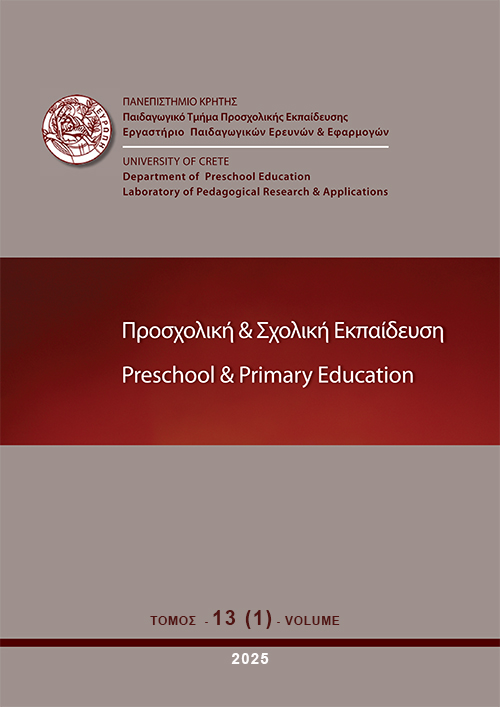Διαφοροποιημένη διδασκαλία και ψυχοκοινωνική προσαρμογή στην πρώτη Δημοτικού: Έρευνα δράση

Περίληψη
Η ομαλή προσαρμογή στην πρώτη τάξη του δημοτικού έχει ιδιαίτερη σημασία για τη μετέπειτα πορεία των μαθητών, ωστόσο ερευνητικά αναδεικνύεται ότι για μία μερίδα μαθητών, αποτελεί περίοδο δύσκολη, που συνδέεται με αρνητικά συναισθήματα. Στην παρούσα έρευνα, η προσέγγιση της διαφοροποιημένης διδασκαλίας μελετήθηκε ως πλαίσιο διευκόλυνσης της προσαρμογής στο δημοτικό σχολείο. Στο πλαίσιο της διαφοροποιημένης διδασκαλίας επιδιώκεται η ανταπόκριση στις μαθησιακές ανάγκες, τα ενδιαφέροντα και το μαθησιακό προφίλ των μαθητών, μέσα από σχεδιασμό εκ των προτέρων, πολλαπλών, ποιοτικά διαφορετικών διδακτικών προσεγγίσεων με θετικά ακαδημαϊκά και ψυχοκοινωνικά αποτελέσματα. Η παρούσα εργασία είναι μια έρευνα δράση, που μελετά και περιγράφει την ψυχοκοινωνική προσαρμογή των μαθητών της πρώτης τάξης του δημοτικού κατά την εφαρμογή της διαφοροποιημένης διδασκαλίας. Τα ποιοτικά δεδομένα συλλέχθηκαν με παρατήρηση, περιγραφικές ρουμπρίκες αξιολόγησης των ψυχοκοινωνικών δεξιοτήτων των μαθητών, γραπτό αναστοχασμό μαθητών και γονέων, ομαδικές συνεντεύξεις μαθητών στην τάξη και ατομικές συνεντεύξεις με εκπαιδευτικούς ειδικοτήτων που δίδασκαν στο τμήμα και γονείς. Τα αποτελέσματα δείχνουν ότι η εφαρμογή της διαφοροποιημένης διδασκαλίας στήριξε πολύπλευρα την ψυχοκοινωνική προσαρμογή των μαθητών στην πρώτη δημοτικού. Ενίσχυσε τη συνέχεια με το περιβάλλον του νηπιαγωγείου, αποτέλεσε ένα υποστηρικτικό πλαίσιο για τους μαθητές κατά την ευαίσθητη περίοδο της προσαρμογής και συνέβαλε στην καλλιέργεια ψυχοκοινωνικών δεξιοτήτων σημαντικών για την προσαρμογή τους.
Λεπτομέρειες άρθρου
- Πώς να δημιουργήσετε Αναφορές
-
Καραγεώργου Η., Φιλιππάτου Δ., & Καλδή Σ. (2025). Διαφοροποιημένη διδασκαλία και ψυχοκοινωνική προσαρμογή στην πρώτη Δημοτικού: Έρευνα δράση. Preschool and Primary Education, 13(1), 83–115. https://doi.org/10.12681/ppej.39154
- Ενότητα
- Άρθρα

Αυτή η εργασία είναι αδειοδοτημένη υπό το CC Αναφορά Δημιουργού – Μη Εμπορική Χρήση – Παρόμοια Διανομή 4.0.
Οι συγγραφείς των άρθρων που δημοσιεύονται στο ΠΡΟΣΧΟΛΙΚΗ & ΣΧΟΛΙΚΗ ΕΚΠΑΙΔΕΥΣΗ διατηρούν τα δικαιώματα πνευματικής ιδιοκτησίας επί των άρθρων τους, δίνοντας στο περιοδικό το δικαίωμα της πρώτης δημοσίευσης. Άρθρα που δημοσιεύονται στο ΠΡΟΣΧΟΛΙΚΗ & ΣΧΟΛΙΚΗ ΕΚΠΑΙΔΕΥΣΗ διατίθενται με άδεια Creative Commons 3.0 και σύμφωνα με την άδεια μπορούν να χρησιμοποιούνται ελεύθερα, με αναφορά στο/στη συγγραφέα και στην πρώτη δημοσίευση για μη κερδοσκοπικούς σκοπούς και με δικαίωμα τροποποίησης μόνον με παρόμοια διανομή (αν αναμείξετε, τροποποιήσετε, ή δημιουργήσετε πάνω στο υλικό, πρέπει να διανείμετε τις δικές σας συνεισφορές υπό την ίδια άδεια όπως και το πρωτότυπο). To Εργαστήριο Παιδαγωγικών Ερευνών και Εφαρμογών του Παιδαγωγικού Τμήματος Προσχολικής Εκπαίδευσης του Πανεπιστημίου Κρήτης και το Εθνικό Κέντρο Τεκμηρίωσης διατηρούν το δικαίωμα να δημοσιεύουν, να αναπαραγάγουν, να παρουσιάζουν στο κοινό, να διανέμουν και χρησιμοποιούν άρθρα που δημοσιεύονται στο ΠΡΟΣΧΟΛΙΚΗ & ΣΧΟΛΙΚΗ ΕΚΠΑΙΔΕΥΣΗ σε οποιοδήποτε μέσο και μορφή είτε μεμονωμένα είτε ως μέρη συλλογικών έργων, για όλο το χρόνο διάρκειας προστασίας της πνευματικής ιδιοκτησίας και για όλες τις χώρες του κόσμου. Αυτό περιλαμβάνει ενδεικτικά και όχι αποκλειστικά, το δικαίωμα δημοσίευσης των άρθρων σε τεύχη του περιοδικού ΠΡΟΣΧΟΛΙΚΗ & ΣΧΟΛΙΚΗ ΕΚΠΑΙΔΕΥΣΗ, αναπαραγωγής και διανομής μεμονωμένων αντιγράφων των άρθρων, αναπαραγωγής ολόκληρων των άρθρων σε άλλη έκδοση του Εργαστηρίου Παιδαγωγικών Ερευνών και Εφαρμογών του Παιδαγωγικού Τμήματος Προσχολικής Εκπαίδευσης του Πανεπιστημίου Κρήτης και του Εθνικού Κέντρου Τεκμηρίωσης και αναπαραγωγής και διανομής των άρθρων ή περίληψης αυτών με χρήση πληροφορικού συστήματος αποθετηρίου.


